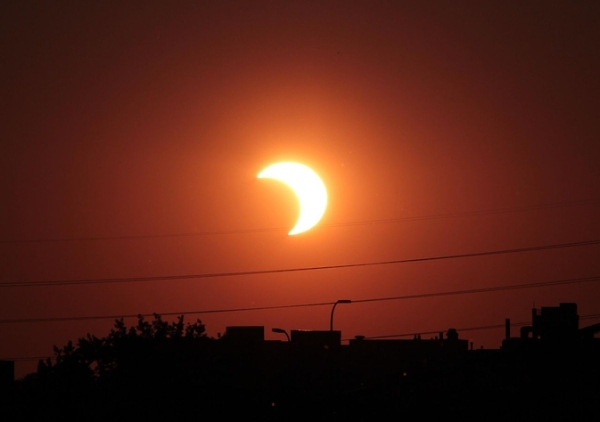Eclipse 230-4p PST Visible in N America: Here’s How, Where to Check It Out TODAY
Eclipses come in pairs: following October 8’s lunar eclipse which was visible in North America and which my family woke to watch at 3am, we have a solar eclipse also visible in North America a nd which we can watch this afternoon. Find out when you can watch the eclipse using this list of eclipse times in major U.S. cities.
nd which we can watch this afternoon. Find out when you can watch the eclipse using this list of eclipse times in major U.S. cities.
Scroll down for SoCal options and how to watch from SAFELY from home.
On the West Coast, the sun is most eclipsed from around 230-4pm and once again Sidewalk Astronomers will be aiding us because it is
NOT SAFE TO LOOK AT THE SUN DIRECT! DON PROTECTIVE GOGGLES OR VIEW IN A SPECIAL TELESCOPE or other accommodations!
Fortunately, organizations like Sidewalk Astronomers and observatories across the country are gearing up to provide us with opportunities to watch safely.
Okay so it’s only a partial eclipse (not a full one) but even a partial eclipse is cool AND there’s also a
MASSIVE SUNSPOT BIGGER THAN EARTH
and YOU just might get a chance to see it during the eclipse! How cool is that?
Learn more about Oct. 23 2014 eclipse from NASA.
Participate in a tweet chat! That’s right, Marshall scientists Mitzi Adams, Sabrina Savage and Alphonse Sterling will be taking questions about the partial solar eclipse on the NASA Marshall Twitter account: http://twitter.com/NASA_Marshall, using the hashtag #askNASA.
You can also check a live Ustream feed of the partial solar eclipse here.
Here in Ventura today, we have none of the usual coastal fog: we are blessed with clear skies and a few high clouds. Perfect for watching the eclipse! Sidewalk Astronomers will be on the Pier (like they were during the lunar eclipse) with special equipment. Visit them from noon- 5pm. I’m bringing my son and a few of his friends so look for us! We’ll be playing at the beach while we catch the progress of the eclipse over several hours. Sounds like a perfect fall day, yes?
If you don’t have access to one of these resources, NASA suggests:
1) Projection: The safest and most inexpensive way to watch a partial solar eclipse is by projection. Place a pinhole or small opening in a card, and hold it between the sun and a screen – giant sheet of white paper works – a few feet away. An image of the sun will be seen on the screen. Projected images of the sun’s crescent during an eclipse may even be seen on the ground in the small openings created by interlacing fingers, or in the dappled sunlight beneath a leafy tree. You can also use binoculars to project a magnified image of the sun on a white card. However, you must never look through the binoculars at the sun.
2) Filters: The sun can be viewed directly only when using filters specifically designed for this purpose. Such filters usually have a thin layer of aluminum, chromium or silver deposited on their surfaces. One of the most widely available filters for safe eclipse viewing is a #14 (or darker) welder’s glass. A welding glass that permits you to see the landscape is not safe. Aluminized mylar manufactured specifically for solar observation can also be used. Mylar can easily be cut with scissors and adapted to any kind of box or viewing device. Only use filters that you know have been approved for solar viewing.
Unsafe filters include color film, some non-silver black and white film, medical x-ray films with images on them, smoked glass, photographic neutral density filters and polarizing filters. Solar filters designed to thread into eyepieces, which are often sold with inexpensive telescopes are also dangerous.
3) Telescopes with solar filters: There are sun-specific telescopes available for sale — or perhaps through a local astronomy club — that are also safe for viewing a partial eclipse.
Top photo and GIF from NASA; middle photo by Art Predator.











This is the link to our group book review on our blog; The Silly Willies.
http://thesillywillies.wordpress.com/2014/10/29/book-review-wild-by-cheryl-strayed/